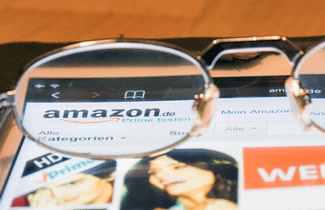As Amazon experiments with Alexa-enabled glasses that will create a 24/7/365 shopping environment, the ecommerce giant will need to acquire a company to make the glasses look good.
__________________________________________________________________________________
By Brad Berens
Lately, I’ve been wondering: now that Amazon — the world’s most interesting and unpredictable company — has acquired and digested Whole Foods, what is its next most likely major acquisition?
 One speculative answer is Warby Parker, the innovative online seller of glasses.
One speculative answer is Warby Parker, the innovative online seller of glasses.
Here’s why.
This week, a Financial Times article (paywall) revealed that Amazon wants to take its home automation business out of the home, freeing Alexa, the virtual digital assistant that comes with Amazon’s Echo devices and latest Fire tablets, to roam the world.
The FT article’s headline was, “Amazon working on first wearables to interact with Alexa,” with the subhead, “Company’s ‘smart glasses’ would come with in-home virtual assistant embedded.”
The quotes around “smart glasses” in the subhead are important, lest the FT reader think that Amazon is creating its own version of the unfairly-maligned Google Glass, or that it is trying to steal the thunder of Magic Leap’s augmented reality glasses (rumored to be available this holiday season).
The Alexa-enabled glasses are connected but not heads-up display (HUD). A pair of sentences near the end of the article makes this clear:
Amazon’s glasses are likely to do away with the camera and screen that made Glass so controversial among privacy campaigners. Dropping those features would also improve the poor battery life that plagued Google’s headset.
The glasses are likely to have two things that go beyond ordinary eyewear: a microphone that lets the wearer speak to Alexa and a bone-conduction audio system that lets the wearer hear Alexa without ear buds.
If Amazon’s smart glasses have neither screen nor camera, then how smart can they be? The answer is, “very.”
But it’s not the technology that’s smart: it’s the strategy.
Alexa-enabled glasses will be an end run around a problem that Amazon faces with smart phones: the default virtual digital assistant is never Alexa.
For Apple’s IOS devices the default is Siri, and the default for most Android devices is Google Assistant. iPhone owners say, “Hey Siri!” to activate the assistant just by speaking, while Android phone owners say, “OK Google.”
In contrast, to access any Amazon app a user has to unlock her or his smart phone, swipe to the app and activate it. That’s too many steps!
Alexa-enabled glasses would put a microphone on the user’s face that is always there, always listening, so the wearer can ask Alexa a question without having to touch her or his smart phone app. (And, yes, wearing a listening device on your face is creepy.)
Alexa-enabled glasses don’t need to be profitable
According to Global Market Insights, by 2020 the eyewear market is expected to exceed $180 billion dollars. That is an alluring market for Amazon on its own merits.
What’s important strategically about Alexa-enabled glasses is that Amazon can use whatever percentage it captures of the hundreds of millions of spectacles sold each year as a quiet distribution strategy for Alexa.
Unlike other glasses makers, Amazon does not have to make a profit selling glasses: instead, it can sell Alexa-enabled glasses at a loss in order to drive adoption of Alexa. The frames could even be free.
It’s hard to compete with free.
_________________________________________________________________________________________________
If Amazon’s smart glasses have neither screen nor camera, then how smart can they be? The answer is, “very.” But it’s not the technology that’s smart: it’s the strategy. Alexa-enabled glasses will be an end run around a problem that Amazon faces with smart phones: the default virtual digital assistant is never Alexa.
_________________________________________________________________________________________________
Massive subsidization is not a new strategy for Amazon: the company offers its Prime service below cost because Prime subscribers spend at least twice as much as non-Prime subscribers.
The same would be true of Alexa-enabled glasses: if online shopping can happen just by murmuring, “Alexa, I want the new John le Carré book,” then impulse purchases will no longer be restricted to the supermarket checkout line.
These glasses will also increase “showrooming” — when people shop offline but buy online. As our just-released Surveying the Digital Future Report shows, 81 percent of Americans already showroom. It can be awkward and embarrassing to whip out your phone to check a price when the Best Buy blue shirt is helping you. With Alexa-enabled glasses, doing so would be less obvious and therefore more attractive.
Amazon will probably include a three to six month free trial of Prime with the purchase of any pair of Alexa-enabled frames, driving even more showrooming and purchasing.
Amazon’s design challenge: the case for buying Warby Parker
Amazon already sells hundreds of different glasses frames, but the world’s largest ecommerce business has two problems: it neither manufactures the frames itself nor does it sell prescription lenses.
Acquiring Warby Parker would solve both of these problems.
Moreover, for Alexa-enabled glasses to succeed, they have to be more than just the least expensive frames available: they also have to look good, be fashionable, be hip.
Design sensibility is not a current strength for Amazon. The company will either have to invest heavily in attractively designed frames or buy that capability via Warby Parker (or one of Warby Parker’s competitors like Zenni Optical).
Amazon could then deploy its enormous logistical expertise to take costs out of Warby Parker’s supply chain, while also creating Alexa-enabled glasses to sell both at WarbyParker.com and Amazon.com.
Amazon spent $13.4 Billion dollars acquiring Whole Foods.
According to Pitchbook, Warby Parker is currently valued at $1.2 Billion, which is a bargain by comparison.
Speaking of Whole Foods, many of the market’s larger locations have oodles of extra space, so it would be easy for Warby Parker branded glasses shops to pop up at local Whole Foods locations.
Like Amazon with its new physical bookstores and experimental robot bodega, Warby Parker has already started to experiment with retail stores, so moving inside Whole Foods would be a natural progression.
With the world’s dominant ecommerce website, Echo devices in the home, Alexa integration with many new cars, Amazon apps on the smart phone, retail locations like Whole Foods and — soon — on-your-face shopping via Alexa-enabled glasses, Amazon is inescapable.
_________

Brad Berens is the Center’s Chief Strategy Officer.
See all columns by the Center.
September 21, 2017

